The Air Force has long boasted an exemplary relationship between its active duty, Air National Guard, and Air Force Reserve Command elements. A variety of blue-ribbon commissions have lauded the rapport among the USAF components as a model for the other armed services to emulate.
However, USAF is not satisfied with “seamlessness” in relations between the three. It is now moving quickly toward what it calls an Integrated Total Force. It would bring about this change by blending the activities of the three elements in order to obtain even greater overall effectiveness, while still preserving their separate cultures.
To emphasize the urgency of doing so, it has even abandoned the buzz-phrase “Future Total Force,” because it’s not something that can be put off.
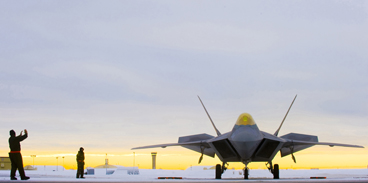 |
Ground crew stand by as an F-22 at Elmendorf AFB, Alaska, prepares to head out on a training mission. Total Force units are full partners on the F-22 and USAF’s other new equipment. (USAF photo by SrA. Garrett Hothan) |
In January, the Air Force took a big step toward the integration of its active force and Air Reserve Components (a term that denotes both ANG and AFRC) when it unveiled a new “roadmap” of all the locations in which new aircraft could be permanently based over the next 30 years. Central to the announcement was the fact that the Guard and Reserve will be full partners on all the new gear.
The announcement—unprecedented in USAF history—listed assets ranging from F-22 and F-35 fighters to systems whose builders hadn’t even been chosen yet, such as the CSAR-X rescue helicopter, C-27 Joint Cargo Aircraft, and the KC-X tanker.
The Guard and Reserve will partner with USAF on the new systems either as “owners” or as joint users, through associate relationships. If the roadmap bears out, Guard and Reserve personnel and units will operate the latest USAF equipment, often as soon as it is available.
The new default concept is that the Guard and Reserve will be thoroughly integrated in all aspects of the Air Force mission, even those in which they have not previously played a role. The Air Force Chief of Staff, Gen. T. Michael Moseley, has instructed his staff to identify any missions lacking Guard and Reserve participation and then explore the quickest way to open such missions to them.
The choice of bases for the new systems was made with extensive input of the Guard and Reserve and came only after meetings last December in which each of the Air National Guard’s state and territory adjutants general, as well as leaders from Air Force Reserve Command, were consulted on the plan.
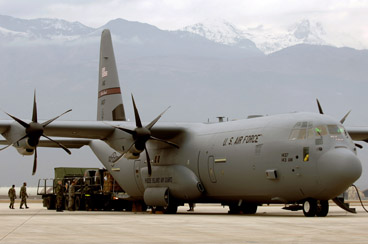 |
A Rhode Island Air National Guard C-130 takes on cargo at Aviano AB, Italy. The Guardsmen will deliver the materiel to Zaragoza AB, Spain. (USAF photo by MSgt. Scott Wagers) |
In making the announcement, the Air Force noted that new systems will be fewer in number than those they replace, but will offer greater capability.
“In numerous instances, the potential locations will capitalize on Total Force Integration efforts,” according to the USAF announcement, “creating innovative organizational arrangements among regular Air Force, Air National Guard, and Air Force Reserve components. This effort takes advantage of the inherent strengths of each of the three components.”
Safeguard the Heritage
The new aircraft, which in many cases can fly more frequently than the ones they replace, will benefit from having a larger ratio of air and ground crews than has been the case with legacy systems, notes Lt. Gen. Raymond E. Johns Jr., deputy chief of staff for strategic plans and programs. The Guard and Reserve will also participate in the operation of unmanned air systems and in new, nonflying missions such as cyber warfare.
The roadmap is provisional, in that it assumes that everything for which the Air Force has stated a requirement will be bought, and that environmental impact assessments won’t create obstacles. Neither is a certainty. The service has long stated a requirement for 381 F-22 fighters, for example, but has only been given authority to buy 183. The F-22 and F-35 also have bigger engines than the F-15 and F-16 they replace, and are noisier, meaning environmental approvals aren’t a slam-dunk, either. The plan also does not delve into basing options on foreign soil.
“There is a rich heritage in the culture of our Total Force,” Johns said, adding that the Air Force needs to preserve that heritage.
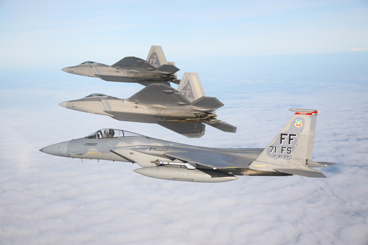 |
Two Raptors from Langley AFB, Va., peel away from a Langley F-15. F-22s such as these are flown by Total Force teams to increase their use-rate. (Photo by Rick Llinares) |
The announcement “gives us a much longer-range view of what will be in our future than we have ever had in my memory,” added Lt. Gen. John A. Bradley, chief of the Air Force Reserve. “It also was built pretty much in the open—very much in the open—as opposed to ‘behind closed doors.'” He added that AFRC was “included in the process … which has not always been done.”
Lt. Gen. Craig R. McKinley, director of the Air National Guard, emphasized the shift away from the term “Future Total Force,” noting “it isn’t future; it’s now.”
In the last few years, many Air Force moves have highlighted the fact that the reserve components are full partners on new systems, and are taking a leading role on some older ones. A few examples:
The Missouri ANG’s 131st Fighter Wing in St. Louis, scheduled to give up its F-15s under the 2005 Base Realignment and Closure (BRAC) commission recommendations, will now partner with the 509th Bomb Wing at Whiteman AFB, Mo., in flying the B-2 bomber, which has a nuclear mission.
New C-17 transports at Hickam AFB, Hawaii, are flown and maintained by about 60 percent active duty personnel and 40 percent ANG. The Guard’s 199th Fighter Squadron at Hickam, which is losing its F-15As due to BRAC, will receive F-22s, and an active unit, the 531st FS, will associate with it.
The 477th Fighter Group, a Reserve unit, is flying the F-22 fighter at Elmendorf AFB, Alaska, in association with the base’s active units.
The Tennessee Air Guard’s 118th Airlift Wing at Nashville Airport will be in charge of training allied nations to fly and maintain older model C-130 transports.
The first Guard-Reserve associate relationship involving a combat delivery system is standing up at Niagara Falls Arpt./Air Reserve Station. The New York Air Guard’s 107th Airlift Wing will partner with the Reserve’s 914th Airlift Wing in flying the C-130.
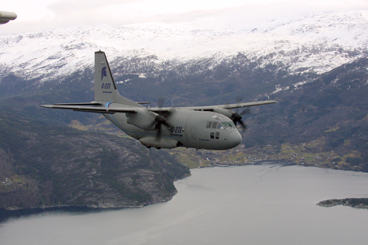 |
A C-27J, the Pentagon’s pick for the Joint Cargo Aircraft. The Air National Guard will operate the first 50 or so C-27Js that the Air Force acquires. (C-27J Team photo) |
Active duty units will associate with existing Reserve and Guard units in Florida, South Carolina, Texas, and Vermont. Previously called “reverse associate” programs, these relationships assign active personnel to Guard and Reserve units.
Included in the roadmap was the announcement that of the first 50 or so of the C-27J Joint Cargo Aircraft that the Air Force will operate, 100 percent will be flown by the Air National Guard. This is the first time in decades that a brand-new aircraft will go straight to the Guard without also being operated by the active force.
That was done because the C-27J is “a wonderful mission for FEMA [Federal Emergency Management Agency] to support” at the state level, “so it made sense to populate [the Guard] first,” Johns said.
More Changes on the Horizon
The announcement of the bases that will host the new equipment is a first step, Johns said, but along with it will come more announcements about how Guard and Reserve forces will associate with the regular force and with each other. That part of the plan has “yet to be written,” Johns said, but it will come soon.
Johns said the bases in the roadmap are more than the Air Force really needs, and it would be inefficient to spread the aircraft out to them all. USAF would like to try to preserve squadrons at a strength of 24 primary aircraft authorized, although it has had to reduce that to 18 in the case of the F-22.
However, the service didn’t try to cull the list of bases at this point, because any left off would cry foul.
Johns observed, “The first thing you’d get [from an unmentioned base community] is, ‘What’s wrong with me? Why are you tossing me out and not giving me a fair shot? Because we’d like to have a follow-on capability.’”
The Integrated Total Force plan is critical because, with planned active end strength hovering at around 316,000 and total reserve components at about 227,000, “we don’t have any ‘benchwarmers,'” Johns said. “Everybody’s on the playing field.”
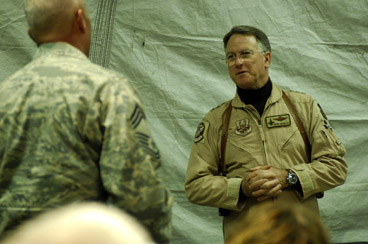 |
In Afghanistan, Lt. Gen. John Bradley (r), chief of Air Force Reserve Command, talks about operations with CMSgt. Stanley Burrows. (USAF photo by SSgt. Joshua Jasper) |
“There’s no extra,” he added. “I don’t have a strategic reserve of force. They’re all playing to the maximum extent that they can. I can surge them when I need to, and I also need them for the long duration.” The ITF plan is “how … we make that work.”
The new roadmap marks yet another step in a long evolution of both the Guard and Reserve. Both components have undergone a substantive evolution in the post-Cold War era.
The Air National Guard checks in at an end strength of about 107,000 people, after a slimming of about 10 percent since the early 1990s. McKinley said the ANG is “very comfortable” with its size in that it can both perform domestic missions and participate in the Air and Space Expeditionary Force without undue stress.
He acknowledged that Air Force Smart Operations for the 21st Century—known as AFSO 21—is looking for efficiencies and ways to reduce activities and billets where it makes sense to do so. However, while he thinks the Guard can probably absorb some new missions, he doesn’t see it shrinking any further.
“There’s probably things we can do better, cheaper, faster,” he said, and the Guard will “take that on big time.” However, he also believes that numbers are important, especially to deal with the unforeseen, such as domestic natural or man-made disasters. He noted that in the spring of 2007, a tornado hit Greensburg, Kans., and the first responders were not Army Guard, but Air Guard from nearby McConnell Air Force Base.
“You want to have robust … community-based capability to do that ‘other’ mission, which at times we don’t think about enough in the Air Force,” McKinley observed.
Noting that top USAF leaders have said that an overall active end strength of 316,000 may be too small, he said the Guard is willing to help fill some of the missions that may be “missing” between the budgeted level and a notional 330,000-strong active force.
“I don’t want to get any smaller,” McKinley said. “I think we’re right where we need to be.”
Recruitment on the Upswing
Guard recruiting, which has fallen below target for a few years, is now back to providing proper end strength. McKinley chalks up the misses in recruiting to the fact that the Base Realignment and Closure process of 2005 caused extreme turbulence for the Guard, given the dislocation of many units in that ordeal.
“I think a lot of members of our units that had been affiliated with flying missions were really perplexed [about] ‘Will I have a job after this? What will they let me do?'” said McKinley. He noted that USAF leadership has made a dedicated effort to maintain “transparency” about its plans in the post-BRAC Guard era. The roadmap is a key element in reassuring members and recruits that “there is a mission out there; there is a future.” He added that “it may not be flying airplanes, … but there are new things for all of us to do, and we’re able to retrain ourselves to do those.”
He said that in mid-2007, “we started seeing people coming in to the recruiters again, as we had before, and starting to get that enthusiasm again.” McKinley said he is “cautiously optimistic” that the Guard has turned the corner on recruiting, adding, “I think the post-BRAC malaise is over.”
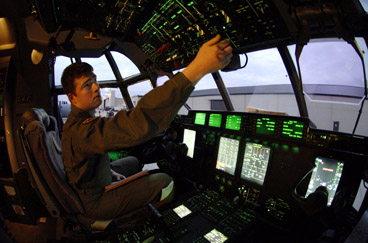 |
At Ramstein AB, Germany, SSgt. Joseph Maker, a loadmaster with the Rhode Island Air Guard, prepares a C-130 for flight. (USAF photo by MSgt. Scott Wagers) |
As an organization, the Air National Guard is far different from what it used to be, McKinley said. The demands of multiple overseas operations caused the nation to call on the Guard as never before. “I will tell you that the ‘weekend warrior’ analogy was pretty much gone” by the late 1990s, McKinley said.
In “all but just a few” specialties, Guardsmen who participate in AEFs are doing so as volunteers, while still meeting the needs of the governors and domestic missions. McKinley pointed out that the Air Guard deployed 1,000 people along the southern border of the US during 2006, to give the US Customs and Border Protection agency a boost in capability.
McKinley warned that it’s important to find balance between the domestic and AEF missions levied on the Guard. Otherwise, it could “break.” What would cause the Air Guard to break
“If we had to substantially change the way we deploy, and stay longer in theater, for longer tours, without … letting Guard commanders run the flexibility of their people, that could push us over the edge,” McKinley said.
He cited, as an example, airline pilots who lose their landing currency in big airliners if they don’t fly within 90 days. If a Guard pilot had to stay in theater longer than that, it would force the airline to spend money retraining him, which in turn would make both the member and the employer less inclined to have him participate in the Guard. Having the flexibility to let people volunteer for the amount of time they can reasonably give “has served us exceedingly well,” McKinley said.
There are some other dangers, as well. The means by which Guard members rack up points for retirement is still “pretty much of a Cold War model,” McKinley said, and hasn’t caught up to modern realities. For example, Guard members supporting the Noble Eagle air sovereignty mission don’t get credited with serving in a contingency operation as those who go overseas do.
While there is new legislation in the works that would allow reservists to retire earlier based on the number of days they’ve served on active duty, the Guard personnel system is “basically the same” as it was “when I joined the Guard in 1980,” said McKinley.
Key to the Future
However, he sees the roadmap as a big boost to Guard retention, given that all the Air Force’s newest systems will be open to Guard participation.
“The post-BRAC era for us is now an era of opportunity, an era of challenge.” The Air Force’s top priority at the moment is recapitalization of aging systems, and “if the Guard can participate in that recapitalization, that’s going to be our key to the future.”
Because of the experience level of its members, the Guard has been able to handle an aging force of aircraft, but McKinley said the Nov. 2, 2007 crash of a Guard F-15C—followed by an extended grounding of most USAF F-15A-Ds—shows that no matter how well old iron is maintained, “there’s a lifetime on an aircraft that you just can’t overcome.”
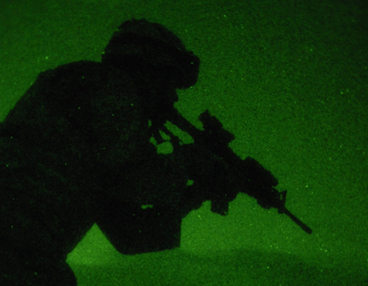 |
A security forces airman participates in a training exercise at Creech Air Force Base in Indian Springs, Nev. The force-on-force expeditionary readiness exercise included active duty, Guard, and Reserve airmen. (USAF photo by A1C Nadine Y. Barclay) |
Despite the fact that the Guard will now be a full partner on all new systems, the “hand-me-down era” probably won’t end overnight, “just because we can’t dig out of this recapitalization hole immediately,” McKinley said, adding that he expects it will be another 10 to 15 years before the Guard’s aircraft are more closely comparable in age to those in the active force, and that will happen because the Guard will in many cases be using the same aircraft as the active component.
“We know there’s not going to be a one-for-one replacement in the fighter force,” McKinley acknowledged, and “more than likely, we’re not going to have a great number more [airlifters], our C-17s, so we’re going to have to use the ones we have exceedingly wisely.” The associate relationships “won’t happen everywhere, but it can happen in a lot of places.”
The next big push in integration, he said, will be to find the places where further association “makes sense.”
The E-8C Joint STARS wing at Robins AFB, Ga., is a “blended” wing with a unique overlapping of Guard and active leadership and personnel. McKinley said the unit has performed flawlessly as “the most heavily mobilized unit in the Air National Guard” since 9/11.
The unit has experienced “growing pains with the cultures and the … tempo,” but has been “one of the most efficient organizations we’ve got in theater.” It is not going to be copied elsewhere for now—associate units work better with less ambiguity of command—but will be “something we learn from,” McKinley said.
Where are the new missions for the Guard
The Cyber Command “mission attracts me because it’s more of a traditional Guard mission,” McKinley said, “where a kid who’s working at Microsoft or Cisco comes and becomes part of a cyber unit, and brings his or her civilian talents from his day job into a world where you don’t deploy very much.”
For the same reason, he likes the unmanned aircraft mission—Predator or Reaper—because the operators can perform their duties at home station without deploying to theater, and expand the number of operators available for a limited amount of equipment. He also is optimistic that the Guard can do more training of allied operators of equipment that is of the same vintage as that being operated by the Guard.
Bradley, head of Air Force Reserve Command, said in his 40-plus years in the Air Force, he’s never seen anything quite like the new roadmap.
“I’ve never seen this kind of openness. I’ve never seen the entirety of it, the strategic view. … This is the best I’ve ever seen us do. So, this is a big deal.”
Associate Relationships
Bradley noted that the idea of associate units started with the Reserve in 1968, for the C-141. It was picked up by Strategic Air Command in 1978, when SAC started getting the KC-10 and realized that there was an untapped resource in the pool of civilian pilots flying the DC-10. Missions continued to be added until the Reserve was flying practically all types in the USAF inventory.
Today, Bradley noted, the Reserve provides “about 20 percent” of Air Education and Training Command’s undergraduate pilot instructors, and provides a good chunk of the training in the F-16, C-130, C-5, and A-10. Recently, Air Force Special Operations Command formed an associate relationship with a Reserve unit, owing to its experience and knowledge.
Such active associate relationships will increase in number. AFRC runs the C-130 business at Pope AFB, N.C., where “we will own the airplanes and [Air Mobility Command] will provide people to fly them and work on them as well.” In the fighter world, the active force will soon associate with a Reserve unit in Fort Worth, Tex.
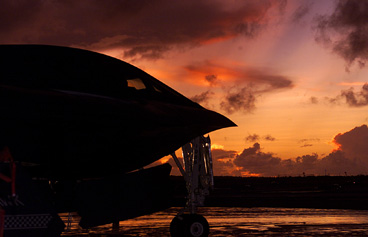 |
USAF plans call for Missouri Air Guardsmen to join the B-2 mission at Whiteman AFB, Mo. Here, the bomber is deployed to Guam. (USAF photo by SrA. Joshua Strang) |
The push for greater associate units “provides more airmen for airplanes that are more capable. We’ll have much more capable airplanes in the future that we’ll need more manpower for.” Moreover, it will pair younger, less experienced air and ground crews with more seasoned people to “mentor them and get them more experienced.”
Bradley said that “nothing is off-limits” in terms of missions that the Reserve can take on. He said AFRC is the “most diverse” command in the Air Force, with a greater variety of missions than any other.
“We do everything AMC does, a lot of what AETC does, we do all the flight-test business except at Edwards [AFB, Calif.], and we do a little piece of that for Air Force Materiel Command. We do all their flight-test at the depot. We do a good bit of what [Air Combat Command] does, we do a fair amount of what AFSOC does, we do a heck of a lot of Air Force Space Command.”
Bradley said that he sees the Air Force Reserve staying put at about 75,000 people, after a decline of about 10 percent in recent years, and they have been very busy.
“More than half of our unit people have been mobilized, 34,000 Reservists, … since Sept. 11, 2001. We’ve had tens of thousands of people who volunteered” who were not mobilized, McKinley said.
Although you can’t tell a Reservist … from an active or Guard member in the field, the Air Force is moving to send all its recruits, both officers and enlisted, through basic schools together.
“More people will grow up knowing each other and having a common set of experiences from going through OTS [Officer Training School] and pilot training and all our [other] training programs together,” Bradley noted. In the associate programs, “we will be better because of those shared experiences.”
The new roadmap shows that the Air Force is serious about bringing its components closer together, by putting new equipment in the Guard and Reserve from the start. “We don’t need to wait,” Bradley said.
However, he sees another value in the roadmap.
“You generate more public support, actually, when you do that,” he said.
“We have to have a lot of public support for what we do. We have to have support on Capitol Hill. The Guard brings a lot of that along, the Reserve brings some of that along. Any member of Congress who helps get us appropriations for what we do is sensitive to what they have in their states and districts and bases. And so, it’s kind of smart to think in those terms. I think it’s a very good idea.”
| A Four-Star Guardsman
In a controversial move, Congress in the 2008 defense bill approved the elevation of the chief of the National Guard Bureau to the rank of four-star general. The current head is Army Lt. Gen. H. Steven Blum. The director of the Air National Guard, Lt. Gen. Craig R. McKinley, offering a “personal opinion,” sees the move as a good thing. The elevation of the Guard Bureau director provides an opportunity “for the National Guard to structure itself to be a more vital aspect of the defense of the United States and contribute more in the worldwide fight against terror. I think the fourth star … enables that,” McKinley said. “Now, it’s fraught with issues of how you structure this new organization,” in terms of how the service Guard chiefs relate to their services, “but those are things that I think will be worked out.” McKinley also said he’s comfortable with the access and “open line of communication” he has with the Chief of Staff of the Air Force. “I’m invited to all the major planning sessions. … I’m never excluded, and so I think that will continue and be enhanced by the empowerment act.” The head of the Guard bureau rightfully should be the main advisor to the Secretary of Defense on Guard issues, he said. McKinley said he is not worried that one of the Guard organizations will be overpowered by the other. “The adjutants general understand that there has to be a bureau in Washington that allocates resources. We can’t have haves and have-nots out there.” If one state’s Guard is heavily mobilized for overseas deployments, “a sister state should be able to fill in and help that governor in times of crisis. That’s what we’ve learned, is that we have to cooperate to graduate. … A Katrina-like event is so big and so massive that we have to call in the strengths of all the National Guards and the active component, and the reserves, to make sure we do the American citizens justice.” |
